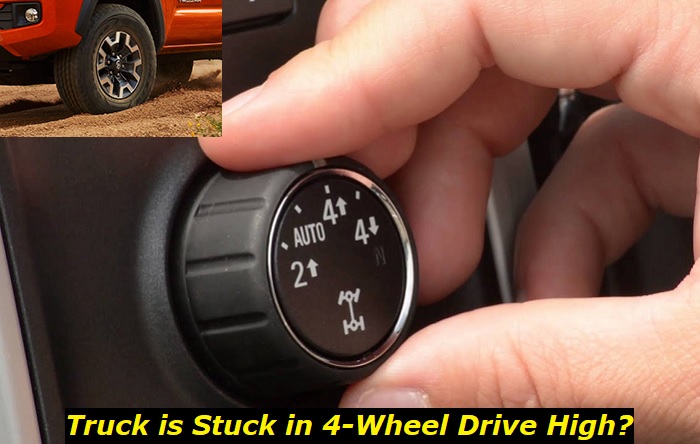When driving in hazardous conditions like snow, ice, rocks, and other situations where it may be difficult to maintain control, a 4-wheel drive (4WD) system surely comes in handy for stabilization and improving traction.
Traction and control are enhanced by activating both pairs of wheels. A heavier vehicle such as a truck also benefits better when on or off the road with this feature. For those who enjoy off-roading and driving in challenging terrains, a 4WD truck truly makes an excellent choice.
Present 4WD drive systems now come in various settings such as 4-Wheel Drive Low and 4-Wheel Drive High to provide you with different advantages when tackling various terrains or conquering varying driving conditions. However, each comes with its pros and cons.
There are also times when shifting to a 2-wheel drive (2WD) can be a better alternative in a given situation. So, what happens when you suddenly have found yourself stuck in one of these modes, particularly in 4WD High?

What You'll Learn Here
We will solve the predicament you're in using some techniques provided by different drivers who have once found themselves in the same situation as you are and based on the advice of experienced mechanics.
The following should be able to help you understand and get around the issue:
- Recap on When to Use 2WD vs 4WD Low vs 4WD High
- Diagnosing the Symptoms of the Problem
- Solutions for the Issue
Recap on When to Use 2WD vs 4WD Low vs 4WD High
Before going ahead, here's a quick refresher on when and where it's recommended to engage the different drive systems of your vehicle to serve as a reminder as to whether or not you are in the ideal mode that could help optimize its performance.
1. 2-Wheel Drive
Two-wheel drive trucks are the most common on the road. They are easy to drive and maintain and are typically more affordable than 4-wheel drive trucks. Two-wheel drive trucks have two powered wheels, usually the front wheels. This means that they can only provide power to two wheels at a time, which oftentimes results in better fuel economy compared to their 4-wheel drive alternatives.
In most cases, 2-wheel drive trucks are fine for driving on paved roads in good weather conditions. This is also preferable if you occasionally use your truck. This is particularly true for those who purchased a vehicle solely based on its appearance rather than its towing or functional abilities.
On the other hand, if you're driving on unpaved roads or in bad weather conditions, you may want to consider a 4-wheel drive truck.
2. 4-Wheel Drive Low
Four-wheel Drive Low is a setting on 4-wheel drive trucks that allows all four wheels to receive power from the engine simultaneously. This setting should only be used in low-traction and low-speed situations, such as driving on challenging off-road trails, on muddy terrains, on bodies of water like flooded areas or creeks, or on roads covered with deep snow. In this mode, the wheels of your auto will rotate slower taking in a lot of torque on the go in order to get you off tough spots.
Aside from putting a lot of tension on your drivetrain, this setting will surely put a lot of stress on both your engine and transmission. Therefore, it's not recommended to get your vehicle in this mode all the time.
3. 4-Wheel Drive High
Four-Wheel Drive High is another setting on 4-wheel drive trucks that lets all four wheels receive power from the engine at the same time. This setting should only be used in low-traction but high-speed situations, such as driving through dirt roads, sand, or slippery pavement. Likewise, using 4-wheel drive every time or in events where 4WD Low is the recommended mode can cause damage to your truck's engine and transmission.
Diagnosing the Symptoms of the Problem
There are a few signs that your truck is stuck in 4-Wheel Drive High mode. The first is that the truck will make a grinding noise when you turn the wheel. This is because the wheels are not timed correctly, which causes friction.
Another sign that your truck is stuck in 4-Wheel Drive High mode is that it will be difficult to steer. This is because the front and rear wheels are locked together, so they can't turn at different speeds.
If your truck is stuck in 4-Wheel Drive High mode, don't try to force it out by driving forward or backward. This could damage the drivetrain. Instead, call a tow truck or mechanic to get your truck out of 4-Wheel Drive High mode.
Solutions for the Issue
There are many ways out of this problem depending on where the issue is really coming from. Based on people who have experienced this issue and professional mechanics, here are the solutions based on its top common causes:
1. Bad Transfer Case
If your truck is stuck in 4-Wheel Drive High mode, it is likely because the transfer case is not working properly. There are several symptoms that can indicate a bad transfer case, including strange noises coming from the transfer case itself, leaks from the transfer case, and difficulty shifting out of the 4-Wheel Drive High mode.
If you suspect that your transfer case is not working properly, the first thing you should do is check the fluid level. If the fluid level is low, add more until it reaches the proper level. If the fluid level is fine but you are still having problems with the transfer case, it is likely that one or more of the internal parts have failed and need to be replaced.
Common parts that fail in the transfer case include the bearings, chains, and gears. In some cases, it may be necessary to replace the entire transfer case. If you are having difficulty shifting out of 4-Wheel Drive High mode, it is also possible that the shift fork, shift rail, or switch is damaged or jammed and needs replacement.
If you suspect that any of these parts have failed, it is important to have the truck inspected by a qualified mechanic as soon as possible. Trying to drive with a faulty transfer case can cause further damage to the truck and may even lead to an accident.
2. Malfunctioning Actuator
One key symptom of a faulty actuator is that the truck will not shift out of 4-Wheel Drive High mode. This is because the actuator is responsible for engaging and disengaging the 4-Wheel Drive system, including its different settings. If the actuator is not working properly, it will not be able to disengage from certain modes of the 4-Wheel Drive system, and the truck will remain stuck in that state.
If you suspect that your truck has a faulty actuator, there are a few possible solutions. The first solution is to replace the actuator. This is the most effective solution, as it will fix the problem and allow you to use the 4-Wheel Drive system properly again.
The second solution is to bypass the actuator, which we do not really recommend for novices in truck modding. This involves disconnecting the wires from the actuator and connecting them directly to the 4-Wheel Drive system. This bypasses the actuator and allows the 4-Wheel Drive system to be engaged without it.
The third solution is to remove the actuator completely. This involves disconnecting the wires from the actuator and removing it from the truck. This will disable the 4-Wheel Drive system entirely, but it may be necessary as a last resort or temporary remedy if the other solutions do not work.
3. Damaged Differential
Differentials are an important part of any four-wheel drive system, and when they become damaged, it can cause a truck to become stuck in 4-Wheel Drive High mode. There are several different signs that a differential is beginning to fail, and if these signs are ignored, the damage can quickly become severe.
One of the first signs of a failing differential is a grinding noise coming from the axle area. This noise will usually be most noticeable when turning, and it indicates that the gears inside the differential are not meshing properly. If this problem is not addressed, it will eventually lead to stripped gears and complete failure of the differential.
Another sign that a differential is beginning to fail is increased wear on the tires. This is because a failing differential will cause the wheels to rotate at different speeds, which puts extra stress on the tires. If this problem is not addressed, it can eventually lead to tire failure.
If you notice either of these signs, it is important to have the differential inspected by a qualified mechanic as soon as possible. In most cases, the damage can be repaired if it is caught early enough. However, if the damage is severe, it may be necessary to replace the entire differential.
Conclusion
The solutions shown here will likely get you out of the problem wherein your truck is stuck in 4-Wheel Drive High mode. There may be other factors directly or indirectly triggering the issue depending on the state that your vehicle is in, the environmental condition it is frequently exposed to, your driving habits, maintenance schedules, and more.
Therefore, if any of these fails to work or you are really having a hard time diagnosing the cause of the problem, the most effective answer to all your troubles is with the help of your trusted mechanic or service center.
About the authors
The CarAraC research team is composed of seasoned auto mechanics and automotive industry professionals, including individuals with advanced degrees and certifications in their field. Our team members boast prestigious credentials, reflecting their extensive knowledge and skills. These qualifications include: IMI: Institute of the Motor Industry, ASE-Certified Master Automobile Technicians; Coventry University, Graduate of MA in Automotive Journalism; Politecnico di Torino, Italy, MS Automotive Engineering; Ss. Cyril and Methodius University in Skopje, Mechanical University in Skopje; TOC Automotive College; DHA Suffa University, Department of Mechanical Engineering






Add comment